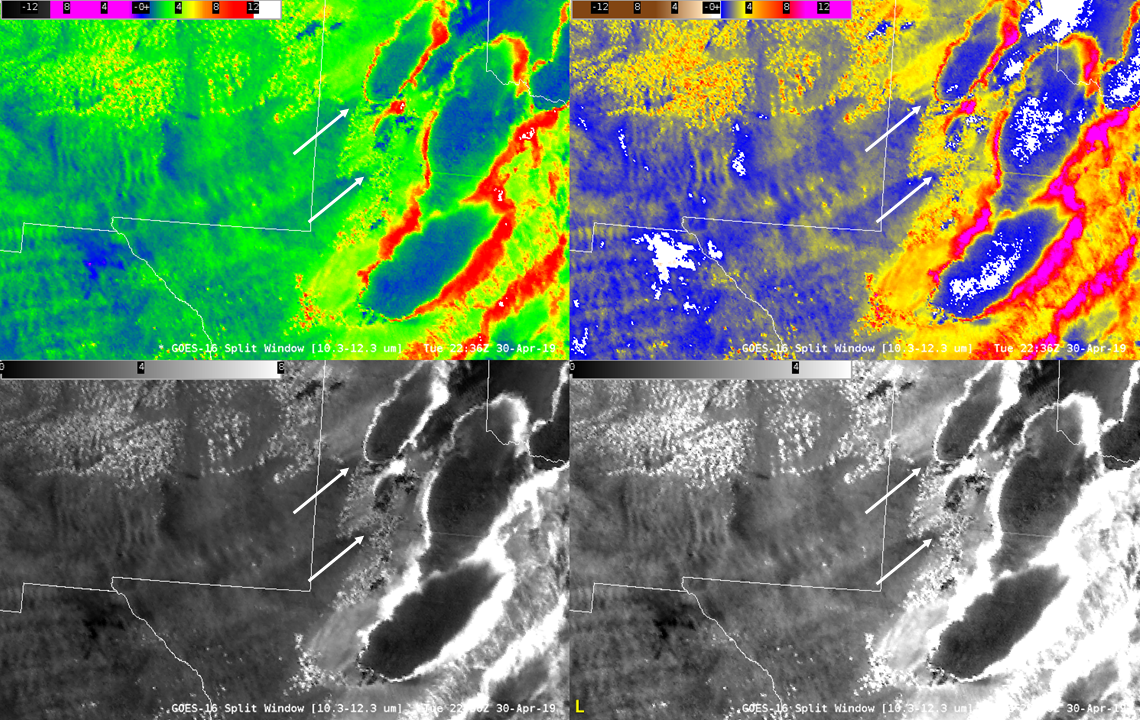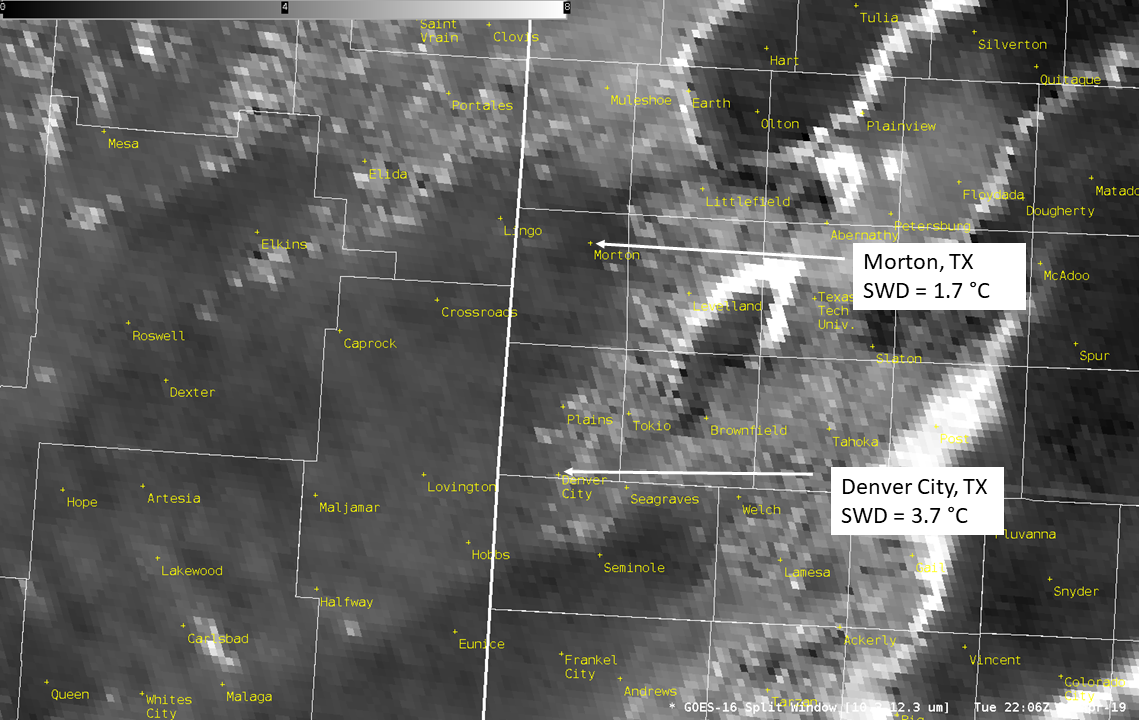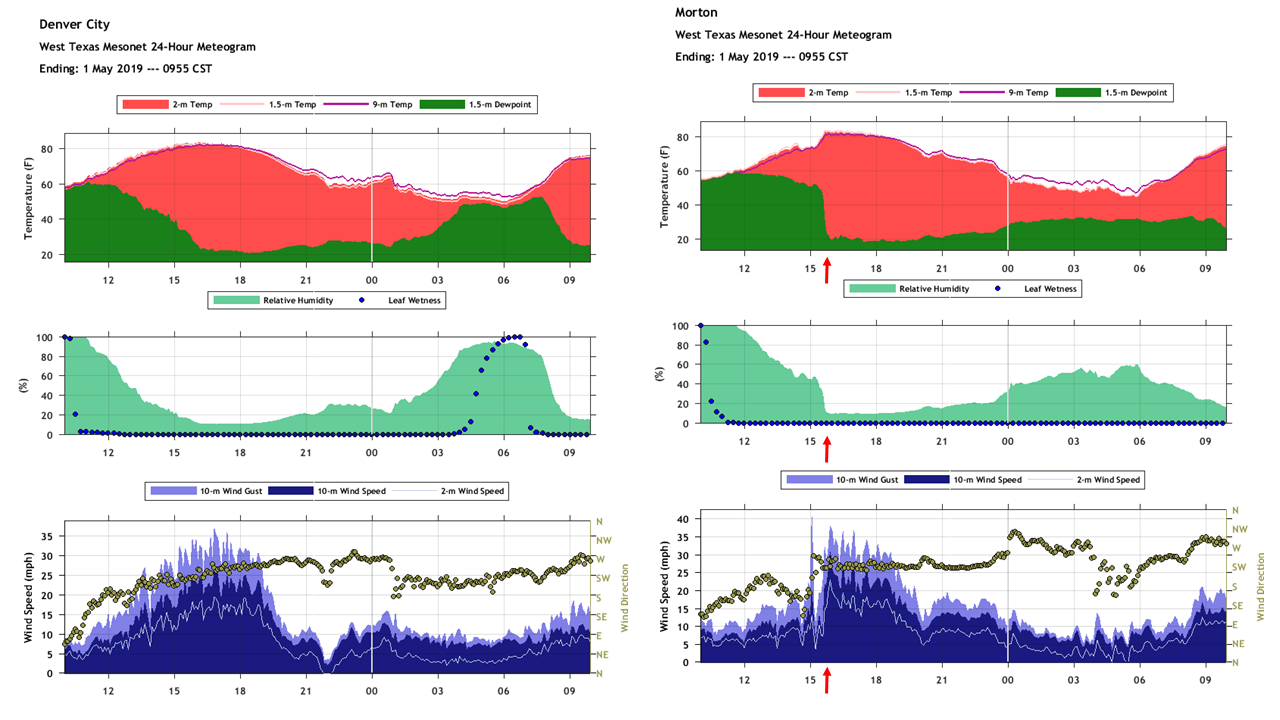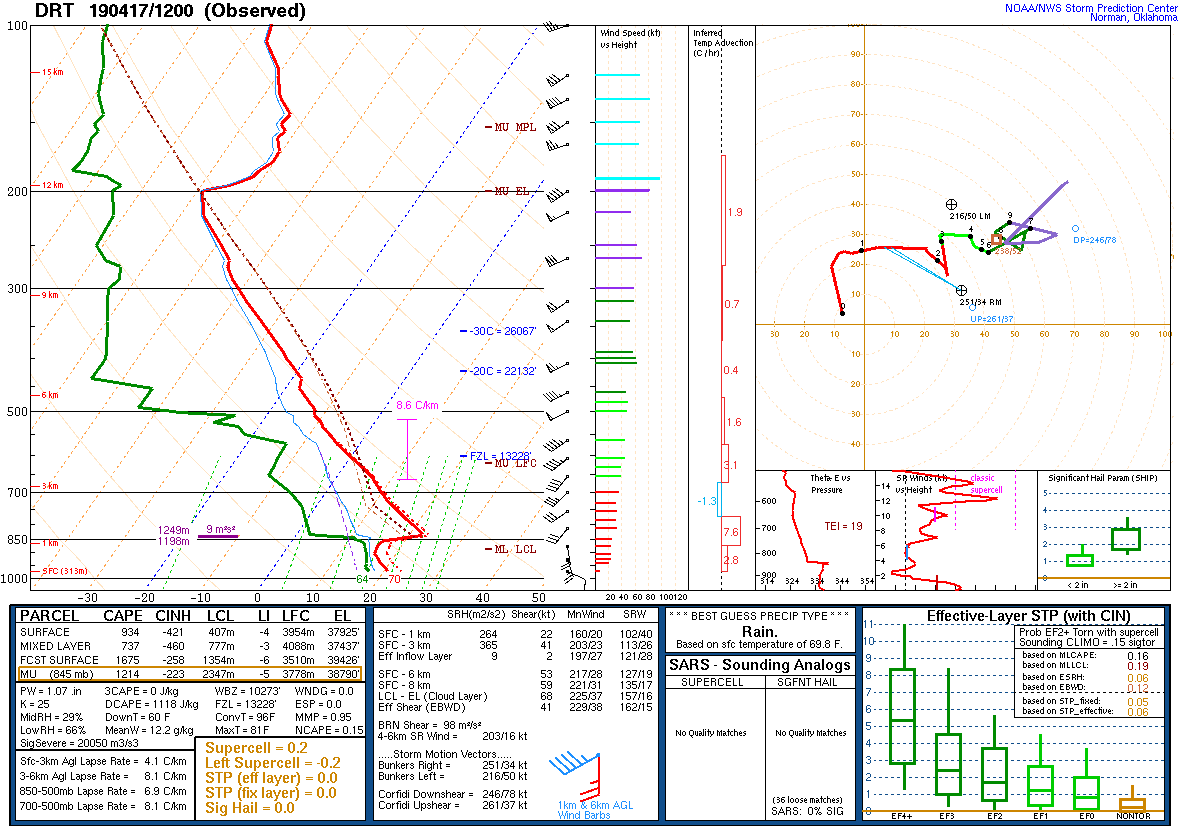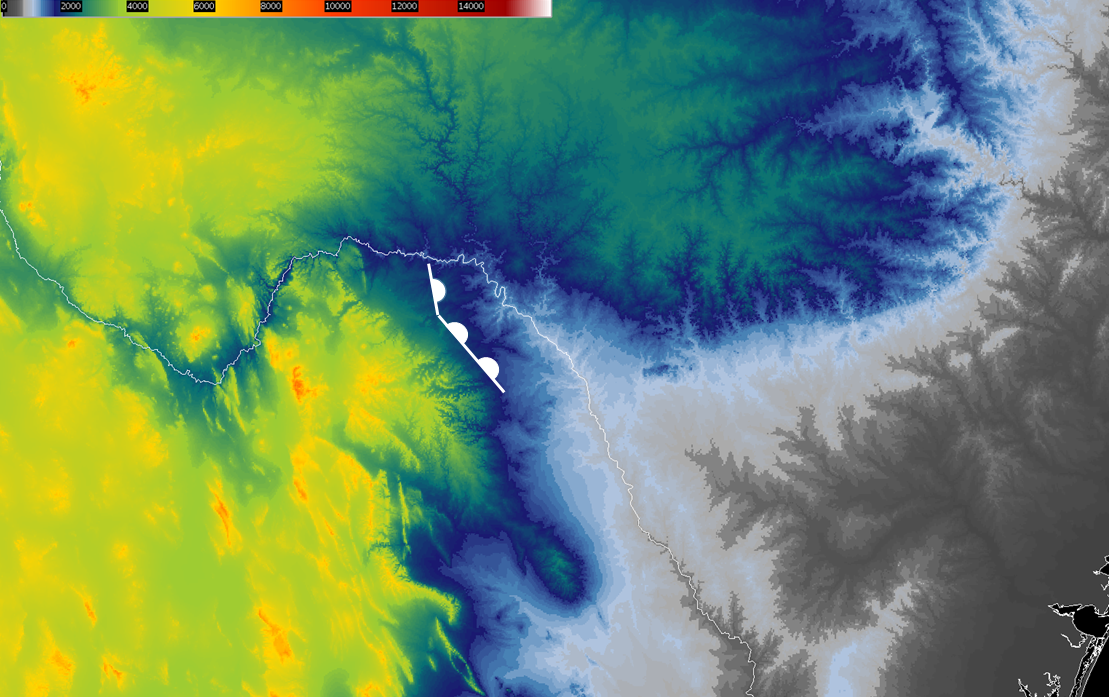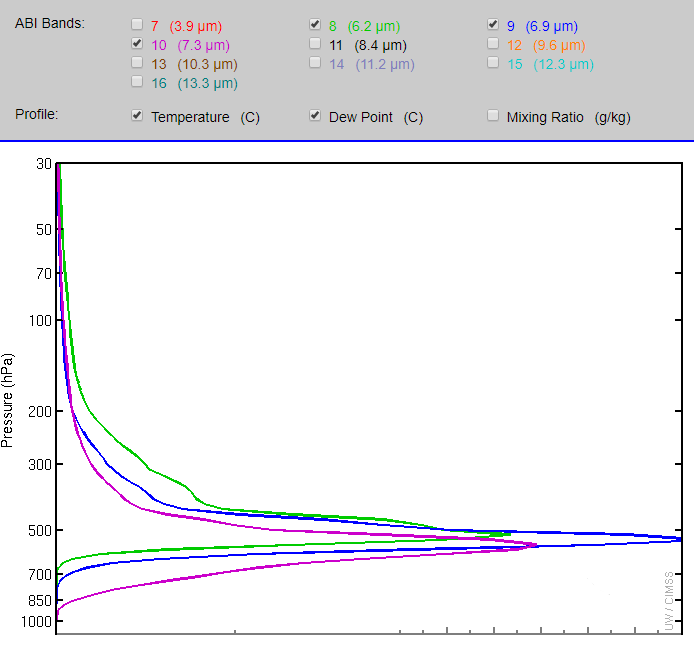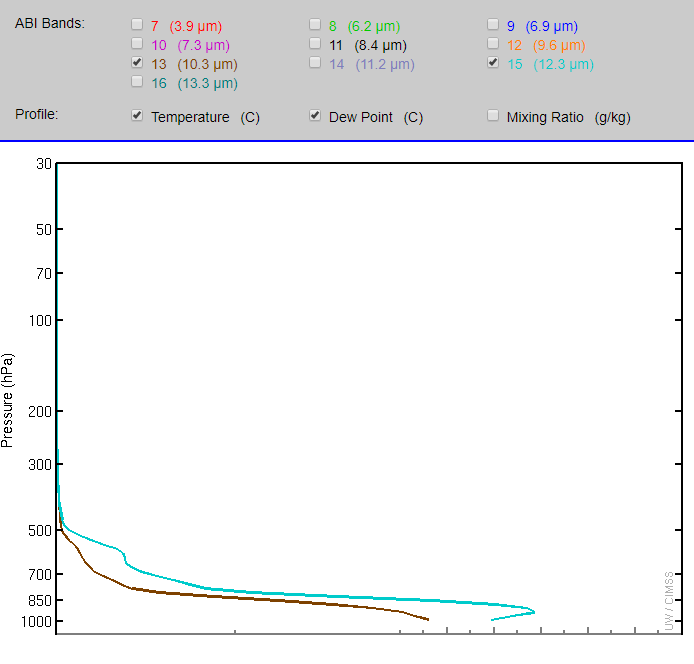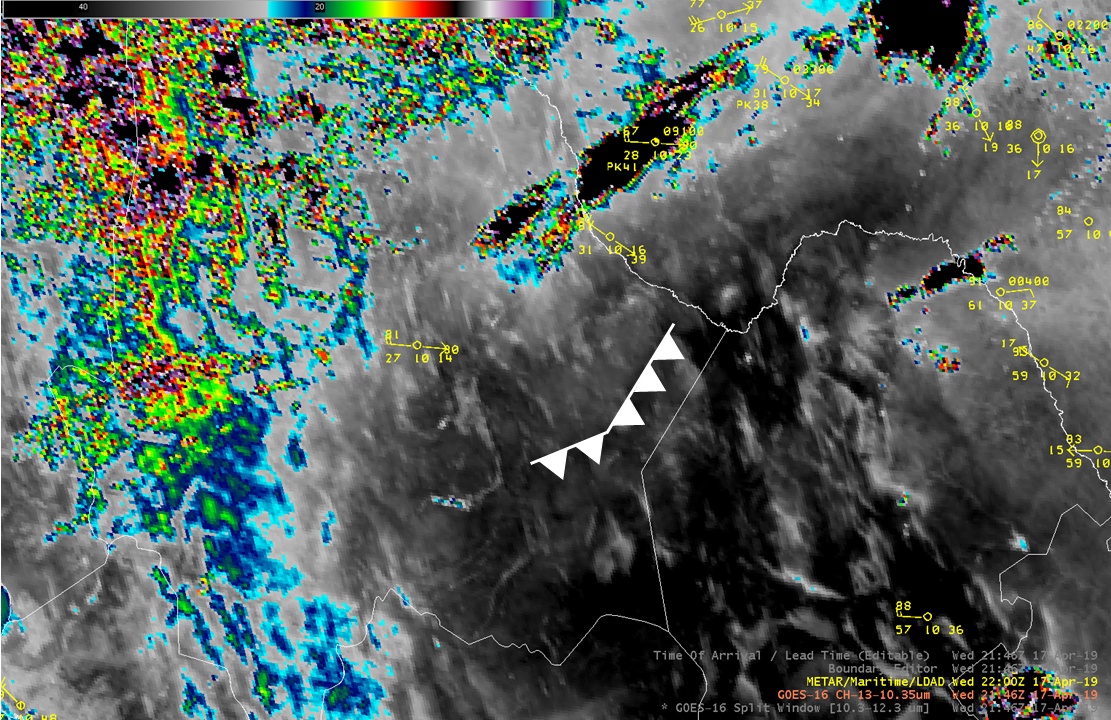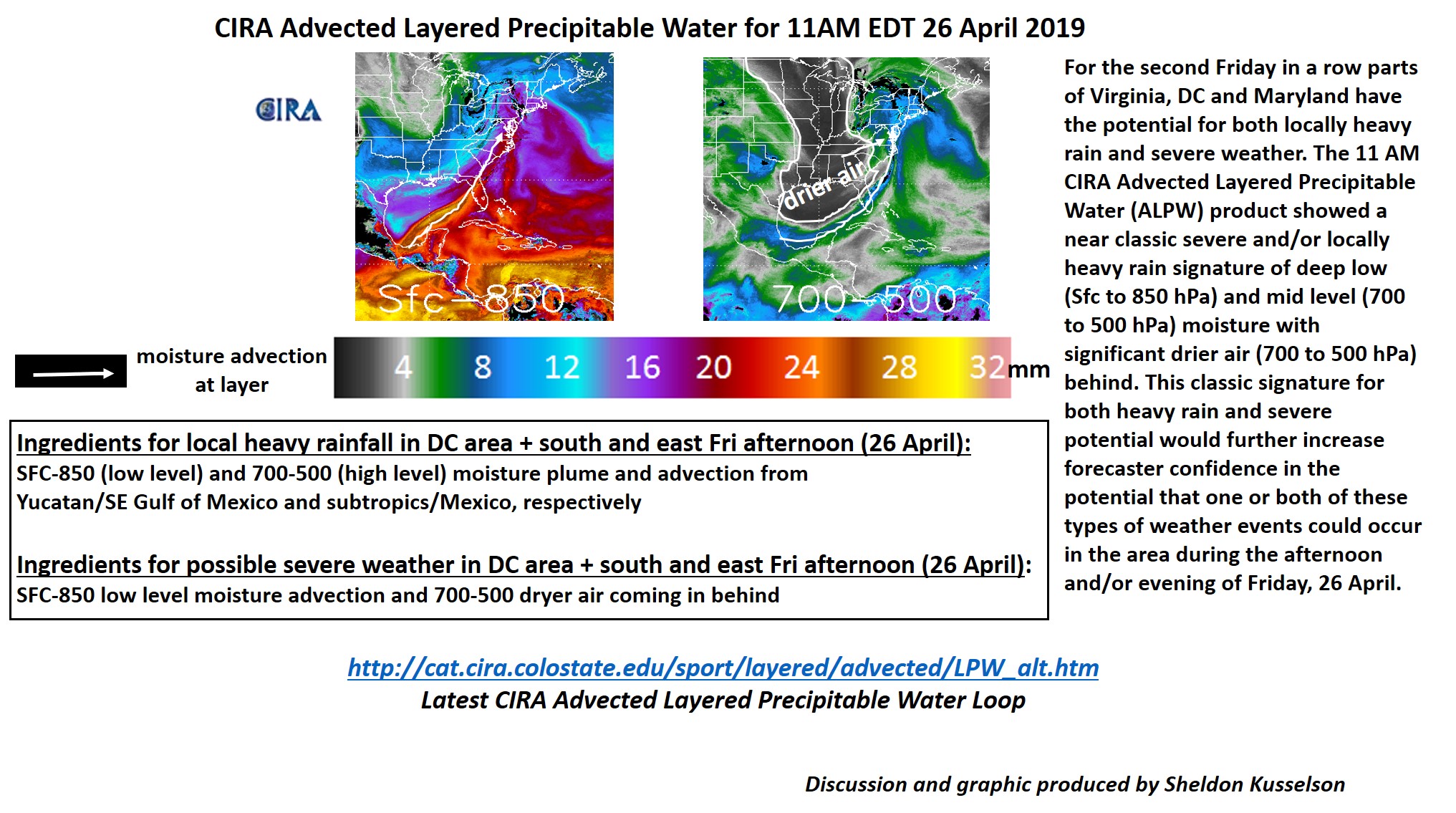VIIRS observations of Katabatic Winds from the Transcontinental Mountain Range Adjacent to the Ross Ice Shelf in Antarctica
May 8th, 2019 by Jorel TorresBy Lewis Grasso and Jorel Torres
One of the goals of the JPSS program set forth by NOAA is enhanced monitoring of the Earth’s environment. One specific type of event of the Earth’s environment that was captured by VIIRS on-board not only the operational NOAA-20 satellite platform, but also the demonstration S-NPP satellite platform was katabatic winds. Katabatic winds that flow through the glacial canyons of the Transcontinental Mountain Range represent a wind regime that transports some of the coldest surface air off the Antarctic ice sheet to the Ross Ice Shelf.
In the figure below a few key features are annotated. The glacial canyons where the katabatic winds flow along the Ross Ice Shelf are denoted. Furthermore, McMurdo research facility is also annotated. As a side note, McMurdo is one of the locations where VIIRS data is downloaded; Svalbard, Norway is the second location. Annotations in the figure are superimposed on top of Imagery Band (I-5, 11.45um), which has a 375-m sub-satellite footprint.
VIIRS offers high-resolution imagery as a means to monitor local-environments, however still images may limit interpretation of the imagery. The following sets of animations provide a GOES-16/17 ABI-like loops from combination of both S-NPP and NOAA-20 VIIRS instruments.

Animation 1: 29 April 2019 (click following link)

Animation 2: 2 May 2019 (click following link) http://rammb.cira.colostate.edu/templates/loop_directory.asp?data_folder=training/visit/JT_loops/Antarctic_Katabatic_Winds/05022019/

Animation 3: 3 May 2019 (click following link) http://rammb.cira.colostate.edu/templates/loop_directory.asp?data_folder=training/visit/JT_loops/Antarctic_Katabatic_Winds/05032019/
For the interested reader here are some references.
The entire February 2003 MWR Volume One article is the following: Antarctic Satellite Meteorology: Applications for Weather Forecasting.
https://doi.org/10.1175/1520-0493(2003)131<0371:ASMAFW>2.0.CO;2
Besides the February 2003 MWR Volume, we offer the following articles.
A Strong Wind Event on the Ross Ice Shelf, Antarctica: A Case Study of Scale Interactions
https://doi.org/10.1175/MWR-D-15-0002.1
Circumpolar Mapping of Antarctic Coastal Polynyas and Landfast Sea Ice: Relationship and Variability
https://doi.org/10.1175/JCLI-D-14-00369.1
Insight into the Thermodynamic Structure of Blowing-Snow Layers in Antarctica from Dropsonde and CALIPSO Measurements
https://doi.org/10.1175/JAMC-D-18-0082.1
Numerical Prediction of an Antarctic Severe Wind Event with the Weather Research and Forecasting (WRF) Model
https://doi.org/10.1175/MWR3459.1
Posted in: Miscellaneous, | Comments closed
Dryline Bulges Identified in GOES-16 Split Window Difference on 30 April 2019
May 7th, 2019 by Dan BikosBy Dan Bikos and Lewis Grasso
During the afternoon of 30 April 2019, a dryline mixed eastward from New Mexico into the Texas panhandle, as seen in this GOES-16 visible loop with METARs overlaid:
Thunderstorms initiate along various segments of the dryline during the animation.
The moisture gradient is substantial across the dryline so we may expect to see this in the GOES Split Window Difference (SWD) (10.3 minus 12.3 micron) product as well:
Upper left: CIRA SLIDER default enhancement applied to the SWD product
Upper right: AWIPS default enhancement (dust_and_moisture_split_window) applied to SWD product
Lower left: Linear enhancement with a modified range of 0 to 8 degrees Celsius applied to the SWD product
Lower right: Linear enhancement with a modified range of 0 to 5 degrees Celsius applied to the SWD product
Water vapor in the boundary layer is an absorbing gas to energy at 10.3 and 12.3 microns that is emitted from the earth’s surface. Water vapor absorbs more energy at 12.3 compared to 10.3 microns; therefore, when the temperature decreases with height the brightness temperature at 12.3 microns is less than the brightness temperature at 10.3 microns, hence the difference is positive. The magnitude of the SWD is greater on the moist side of the dryline compared to the dry side.
The above animation shows why it’s important to experiment with different color tables and range when looking at imagery. Certain features of interest may stand out more than others. For example, since there is a temperature dependence in the SWD, there is a diurnal variation in the animation as we approach sunset in the later half. The diurnal variation may mask the moisture variation of interest, this is particularly true of the color tables in the top two panels, whereas the diurnal variation is not as obvious in the bottom two panels.
One feature that the SWD product really highlights more than visible imagery is the fact that there are smaller scale bulges along the dryline. These are important as they may be indications of localized moisture convergence which may trigger convective initiation. The smaller scale bulges are annotated with white arrows on the image below:
In the loop, notice that these smaller scale dryline bulges appear earlier in the bottom two panels compared to the top two.
The visible imagery shown earlier does show indications of some cumulus along segments of the dryline, so are these regions actually more moist or being obscured by clouds as seen in the GOES imagery? To help answer that question we introduce surface observations from the west Texas Mesonet. Below is a zoomed in SWD image using the linear color table and range of 0 to 8 degrees Celsius at 22:06 UTC. At that time, there are two dryline bulges evident in the SWD product:
The SWD product suggests that Denver City, TX is still on the moist side of the dryline while Morton, TX is on the dry side. The meteogram below is from the observations at those locations, red arrows for the timeline in the Morton meteogram indicate the time of the above image (near 2200 UTC):
Meteograms courtesy of the West Texas Mesonet.
The dewpoint (shown in the solid green curve) clearly drops at Morton, TX BEFORE it does so in Denver City, TX. This is confirmation that the features identified in the GOES-16 SWD product are indeed associated with smaller scale dryline bulges. In fact, note the winds at Morton, TX increase in speed and veer in direction before it does so in Denver City, TX.
We conclude with a comparison of the GOES-16 SWD product with other familiar bands (0.64 micron visible, 10.3 micron IR, and 7.3 micron water vapor):
How well do the dryline bulges discussed above show up in other bands?
Which bands can you see outflow from the southernmost storm in?
Posted in: Convection, GOES R, Severe Weather, | Comments closed
17 April 2019 thunderstorm event over northern Mexico as observed by GOES-16
May 1st, 2019 by Dan BikosBy Louie Grasso and Dan Bikos
On the day of 17 April 2019 observations indicated a significant upper-level trough over the southwest portions of the US. As is typical with this type of synoptic setup, southwesterly flow ahead of the trough existed over northern Mexico extending northeastward into Texas. In addition, this synoptic setup is associated with the development of a dryline in Texas and northern Mexico. In the following animation:
Upper left: GOES-16 Split Window Difference (SWD; 10.3 – 12.3 micron) with METARs
Upper right: GOES-16 Visible (0.64 micron)
Lower left: GOES-16 Low-level water vapor band (7.3 micron)
Lower right: GOES-16 Air Mass RGB product
the METARs indicate advection of warm moist air from the Gulf of Mexico with dewpoints in the upper 60s along with drier southwesterly flow with dewpoints in the low 20s over southwest Texas and northern Mexico. Several features are evident in the SWD product that are absent from the visible imagery. For example, a moist boundary layer is displayed by deep orange/red colors ; there are two regions of blowing dust displayed as blue/purple, as shown below:
In advance of the synoptic scale trough, warm dry air is seen in the GOES-16 7.3 micron band imagery advecting northward from Mexico (yellow color) into central Texas and is associated with an Elevated Mixed Layer (EML) as confirmed by the morning Del Rio, TX sounding:
The air mass RGB product also shows the dryline quite clearly, in support of the SWD product. The above animation ends in early afternoon prior to convective initiation.
A few sequence of events are evident in the above animation that are associated with changes in the pre-storm environment that may lead to convective initiation. First, in the 7.3 micron imagery a region of cooling occurred coincident with the moist boundary layer in the SWD product (see annotated figure above). In particular, the western edge of the cooling is stationary at 7.3 micron while the eastern edge was advected northeastward with the mean flow.
In the above image, which shows topography, the western edge of the moist layer is annotated with the conventional dryline symbol. Although the dryline extends well into central Texas, the portion annotated in the figure is bounded by the approximate 2000 foot increase in elevation to the west.
As indicated in the 7.3 micron imagery in the above loop, cooling was coincident with the dryline segment. An open question becomes, is the cooling observed in other GOES-16 water vapor bands?
The following animation:
Shows the 3 GOES-16 water vapor bands in addition the to the IR band at 10.3 microns. Note that the region of cooling observed in the 7.3 micron band also became evident at 6.9 microns, however at 6.2 microns we do not see this cooling signature. An explanation is hypothesized that makes use of weighting functions, as shown below from the 12Z Del Rio, TX sounding:
Figure courtesy UW/CIMSS
In the weighting function profile, notice that overall the weighting function profile for the 7.3 micron band (magenta) existed at lower altitudes compared to the other 2 water vapor bands. Likewise, the weighting function profile for the 6.2 micron band (green) is in general above the other 2 water vapor bands. The interpretation is that the energy detected by GOES-16 ABI originated in the area between the curve and the vertical axis of each respective weighting function profile. A word of caution, energy detected by the satellite is not coming from just the peak. As a result of the relative position of each weighting function, brightness temperatures at 7.3 microns are generally warmer than at 6.9 microns which are themselves warmer than 6.2 microns. The cooling at 7.3 microns is likely caused by ascending motion at the western edge of the moist boundary layer due to backing surface winds forcing the moist boundary layer up the eastern slope of the ridge line depicted in the topographic map. This can be characterized by convective pre-conditioning of the environment for potential convective initiation.
As mentioned above, the moist boundary layer is evident in the SWD product. One explanation utilizes the weighting function profiles as shown below from the 12Z Del Rio, TX sounding for the 10.3 and 12.3 micron bands:
Figure courtesy UW/CIMSS
As seen in the figure, the entire weighting function profile for 10.3 microns is contained within the weighting function profile for 12.3 microns. As a result, absorption and re-emission of energy occurs at cooler temperatures at 12.3 microns compared to 10.3 microns. Consequently, the values of the SWD brightness temperatures is positive.
During the pre-conditioning stage, a few events can be identified. In the following loop:
At approximately 2146 UTC blowing dust, suggestive of downward mixing of high momentum air, headed eastward towards the moist layer (top left panel). The development of cumulus, cumulus congestus, and towering cumulus occurred on the western edge of the moist layer (top right panel). Further, there is evidence of orphan anvils around 2146 UTC. Also notice in the 7.3 micron imagery the progression of the cooling over a larger area above the moist layer (lower left panel). In addition, the westward migration of the moist layer in response to backing winds as evidence in the top left and bottom right panels. Lastly, evidence of the cold front is seen in the METARs on the upper left panel due to veering surface winds and decreasing temperatures. Also, the leading edge of cooler air is indicated by a subtle blue region expanding southward towards the moist layer in southwest Texas. The expanding cold front is also slightly less subtle in the lower right panel. These processes continued over the next few hours until convective initiation occurred slightly prior to 0000 UTC 18 April 2019.
One technique to increase contrast of features of interest is to modify color tables. For example, in our cold front of interest, we created one possible color table to apply to the 10.3 micron band. At 22:46 UTC a segment of the cold front is denoted by a standard symbol in the figure below as means to aid the reader in identifying the leading edge of the cold airmass.
The readers attention is directed towards the evolution of the cold front in the following loop. During the loop (click link)
notice that convective initiation occurs coincident with the region of cooling observed that was annotated in the 7.3 micron image above. In particular, convective initiation occurs prior to the arrival of the cold front in the IR loop above. This suggests that convective initiation occurred as a result of a process independent of the cold front. As an aside, note that convective initiation in Texas occurs in association with the cold front.
In the Del Rio, TX WSR-88D reflectivity loop:
From the start of the loop, and prior to convection initiation, through about 0106 UTC horizontal streets rotate counterclockwise consistent with backing winds which would aid in the secondary circulation along the sloping ridge in northern Mexico. Also recall the onset of orphan anvils as discussed above along with blowing dust and cooling at 7.3 microns combined indicate pre-conditioning of an environment towards convective initiation ahead of the cold front. Around 0030 UTC convective initiation occurs in the region of interest in northern Mexico. Also note in the radar imagery the two modes of convection – linear to the north and isolated to the south with a well defined right moving supercell.
Another useful tool to monitor convective initiation is the time-of-arrival tool in AWIPS. Here it is used with the SWD product to track a dust plume that is interpreted as the leading edge of strong southwest flow heading towards our region of cooling at 7.3 microns and separate from the cold front. As seen in the loop
as the dust (purple) advects northeastward a line of shallow cumulus form and is interpreted as the leading edge of the strong southwesterly flow that eventually arrives at the region of cooling at 7.3 micron triggering convective initiation independent of the cold front.
One last item to note: the loop speed of the above IR loop is critical in being able to identify the movement of subtle features. If the loop speed is too low, identification of certain features may be difficult or impossible. Therefore it is suggested that the reader experiment with different loop speeds and the rock feature to aid in identification of features of interest.
Posted in: Convection, Dust, GOES R, Severe Weather, | Comments closed
ALPW product for 26 April 2019 heavy rain / severe thunderstorm event
April 26th, 2019 by Dan BikosPosted in: Convection, Heavy Rain and Flooding Issues, Hydrology, | Comments closed
Nighttime Fog Monitoring
April 24th, 2019 by Jorel TorresSatellite fog monitoring during the nighttime can be a challenge since geostationary datasets are limited to infrared imagery. However, with the new GOES-16/17 and JPSS datasets users can employ polar-orbiting and geostationary imagery to identify and monitor areas of fog and low stratus (a.k.a liquid water clouds). As meteorologists, we know that fog can significantly reduce ‘near-surface’ visibilities affecting aviation and shipping industries along with the general public. Below is a static comparison over eastern Kansas and western Missouri highlighting the SNPP – VIIRS NCC, the GOES-16 Night Fog Difference and Nighttime Microphysics RGB products; all imagery has hourly METAR surface observations overlaid (i.e. shown in green). Note the hourly surface observations are at 0800Z, 24 April 2019, while satellite observations are at ~0747Z, 24 April 2019.
SNPP VIIRS Near-Constant Contrast (NCC) at 0747Z, 24 April 2019
NCC, a derived product of the Day/Night Band (DNB), illuminates atmospheric features and can sense emitted light sources (i.e. city lights) and reflected light sources (i.e cloud cover) during the nighttime. NCC is known as ‘nighttime visible’ imagery that appears similar to 0.64μm daytime visible imagery. In the imagery below, NCC observes emitted lights from cities and towns that reside along the interstates and in rural areas of Kansas and Missouri. Various levels of cloud cover encompass south-central and eastern Kansas along with western Missouri, where areas of fog are not conspicuous without the assistance of surface observations (i.e. fog indicated by parallel, horizontal green lines). In contrast, in northwestern Kansas, NCC observes fairly clear skies.

GOES-16 Night Fog Difference (10.3μm- 3.9μm) at 0746Z, 24 April 2019
Using an approximate time stamp, the GOES-16 Night Fog Difference is utilized. The Night Fog Difference product employs a channel difference of the 10.3μm Brightness Temperatures (BT) minus the 3.9μm BT to identify the fog and low stratus. Liquid water clouds are depicted as positive Brightness Temperature Differences (BTD) (i.e. seen in blue in the imagery below) since liquid water droplets do not emit radiation at 3.9μm but do at 10.3μm; employing the channel difference computes to a positive BTD. Conversely, ice crystals that are embedded in high clouds exhibit a negative BTD (i.e. in grey, refer to the bottom-right of the image).
Note there is an ellipse in western Kansas that observes positive BTD indicating fog. But is it really fog or low stratus we are seeing? The answer is ‘No’. Remember, the NCC product (above) observed clear skies in this area, where the surface observations validate the NCC. This is a false alarm that is produced by the Night Fog Difference product, and it is critical for users to validate this product with surface observations.

GOES-16 Nighttime Microphysics RGB at 0746Z, 24 April 2019
For further differentiation between fog and other types of clouds, look to the Nighttime Microphysics RGB (seen below) that employs the 10.3μm-3.9μm BTD and the 12.4μm-10.4μm BTD. Notice within the same ellipse in western Kansas the RGB observes clear skies (light pink) similarly to NCC and the surface observations.

Posted in: Aviation Weather, Fog, GOES, POES, Satellites, Visibility, | Comments closed

